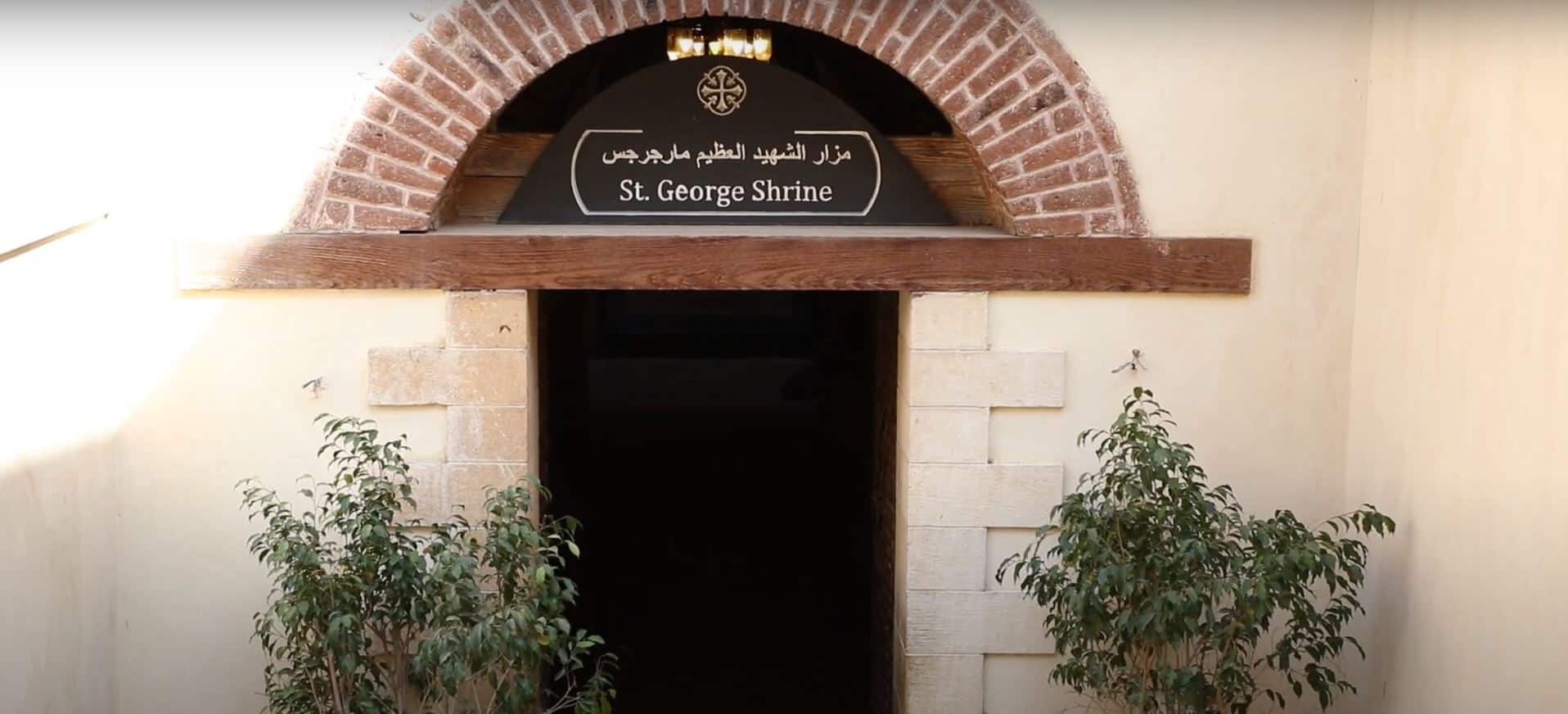Church of St. George – Egypt

Updated On: April 18, 2024 by Ahmed Samir
Egypt, a land steeped in ancient history and rich cultural heritage, is not only famous for its pyramids and pharaohs but also for its diverse religious landmarks. The Church of St. George is a testament to Egypt’s Christian heritage and enduring faith. Located in the heart of Cairo, this magnificent church has a history that spans centuries and continues to be a beacon of spirituality and history for both locals and visitors alike.
This comprehensive article will delve deep into the history, architecture, significance, and enduring influence of the Church of St. George in Egypt. We will explore the rich tapestry of Coptic Christianity, its role in Egyptian society, and how this remarkable church has played a pivotal role in preserving the faith and heritage of a devout community.
Tracing the Origins of the Church of St. George
The Church of St. George, also known as “Mari Girgis” in Arabic, is an ancient Coptic Christian church in the heart of Old Cairo, within the Coptic Quarter. The church is dedicated to Saint George, a revered Christian martyr widely venerated in both Eastern and Coptic Orthodox traditions. It is believed to have been built on the site where St. George was imprisoned and tortured for his Christian faith during the Roman Empire.
The date of the church’s establishment is debated among historians. Still, it is generally believed to have been founded during the 10th century, making it one of the oldest churches in Egypt. Over the centuries, the Church of St. George has undergone several renovations and expansions, each preserving and enhancing its architectural and historical significance.
The Magnificent Design of the Church of St. George
The Church of St. George is a stunning example of Coptic architecture, characterized by its distinctive features that reflect the Christian faith and culture of the region. The church’s exterior is adorned with intricate Coptic crosses and beautifully crafted stone carvings depicting biblical scenes and saints.
The church’s interior is breathtaking, with its high vaulted ceilings, elegant arches, and intricately decorated walls. The sanctuary, where the altar is located, is the most sacred part of the church and is adorned with richly decorated icons and religious symbols. Vibrant colours and detailed frescoes add to the overall sense of spirituality and awe-inspiring beauty.
The Church of St. George also features an underground crypt, where visitors can explore the ancient catacombs and burial chambers. These catacombs are a testament to the early Christian community’s devotion to their faith and desire to be buried near a holy site.
Spiritual Reverence at the Church of St. George
The Church of St. George holds immense religious significance for Coptic Christians in Egypt. Coptic Christianity, which traces its roots to the apostolic times, is one of the oldest Christian traditions in the world. The church is a focal point for Coptic Christians in Egypt and serves as a centre for religious ceremonies, liturgical worship, and spiritual gatherings.
St. George, to whom the church is dedicated, is a revered figure in Coptic Christianity. He is considered a symbol of unwavering faith and courage in the face of persecution. The church’s association with this legendary Christian martyr deepens its spiritual importance and makes it a place of pilgrimage for Copts and Christians worldwide.
Annually, on 23 April, Coptic Christians celebrate the feast of St. George, a day of great religious significance. Pilgrims and worshippers from far and wide flock to the Church of St. George to participate in the celebrations, attend liturgical services and seek blessings. The church becomes a vibrant hub of religious activity during this time, further emphasizing its pivotal role in the Coptic Christian calendar.
Preservation of Heritage
Beyond its religious importance, the Church of St. George is vital in preserving the cultural and historical heritage of Coptic Christianity in Egypt. The church, with its ancient architecture and sacred relics, provides a tangible link to the past, allowing visitors to connect with the rich history of the Coptic community.
The church also houses a museum displaying ancient Coptic artefacts, manuscripts, and religious items. These artefacts offer insights into the Coptic people’s daily life, rituals, and artistic traditions throughout the centuries. Preserving these treasures is crucial for understanding Egypt’s cultural and religious evolution.
Interfaith Harmony
The Church of St. George symbolises interfaith harmony and coexistence in a country known for its religious diversity. Egypt is home to a significant Christian minority, primarily composed of Copts, who have faced various challenges and periods of tension throughout history. However, the Church of St. George remains where people of different faiths come together to appreciate its historical and spiritual significance.
The church has also promoted dialogue and understanding between Coptic Christians and their Muslim counterparts. The shared respect for religious landmarks like the Church of St. George fosters a sense of unity and mutual respect among Egypt’s religious communities.
Attractions in the Coptic Quarter of Cairo
The Coptic Quarter in Cairo, Egypt, is a historic and culturally rich neighbourhood that boasts many attractions that offer a unique glimpse into the country’s Christian heritage and its broader historical and cultural significance. As you wander through the narrow alleyways and cobblestone streets of this quarter, you’ll encounter a fascinating array of attractions:
- The Hanging Church (Saint Virgin Mary’s Coptic Orthodox Church): One of the most iconic landmarks in the Coptic Quarter, the Hanging Church is known for its remarkable architecture. It appears to “hang” above the ruins of a Roman fortress, which adds to its mystique. You’ll find beautiful Coptic artwork, religious icons, and a serene atmosphere inside.
- Coptic Museum: Located near the Hanging Church, the Coptic Museum is a treasure trove of Coptic Christian artefacts. Its exhibits include ancient manuscripts, textiles, sculptures, and religious art. It’s a must-visit for those interested in delving deeper into Coptic culture and history.
- Ben Ezra Synagogue: Situated near the Coptic Quarter, this historic synagogue holds significance for Jewish and Coptic Christian communities. It’s a testament to the religious diversity and coexistence in the area.
- Virgin Mary and St. Sergius Church: This ancient church is believed to have been built on the site where the Holy Family took refuge during their flight into Egypt. It holds profound religious significance for Coptic Christians and is a place of pilgrimage.
- The Coptic Orthodox Patriarchate: In the vicinity of the Coptic Quarter, you can find the residence of the Coptic Orthodox Pope. While only sometimes open to the public, it’s a significant religious and historical site.
Exploring the Coptic Quarter in Cairo is a journey through time, faith, and culture. These attractions collectively create an immersive experience that allows visitors to appreciate the rich tapestry of history and spirituality that defines this historic neighbourhood in Egypt’s capital city.
More Attractions Near the Church of St. George
- Babylon Fortress: Situated nearby, the remnants of the Babylon Fortress offer a glimpse into ancient Egyptian history. This ancient fortress once protected the city and is a fascinating archaeological site to explore.
- Amr Ibn Al-As Mosque: This is the oldest mosque in Egypt and is also located near the Church of St. George. It’s an important historical and architectural landmark in Cairo.
- Khan El Khalili Bazaar: After exploring the religious and historical sites, you can visit this bustling bazaar, known for its traditional Egyptian crafts, jewellery, spices, and souvenirs. It’s a great place to experience local culture and shop for unique items.
- The Egyptian Museum: While not within walking distance, the renowned Egyptian Museum in Tahrir Square is a short taxi or metro ride away. It houses an extensive collection of ancient Egyptian artefacts, including the treasures of Tutankhamun.
- Al-Azhar Park: A bit farther from the Coptic Quarter but still accessible, Al-Azhar Park offers a peaceful oasis with beautifully landscaped gardens, historic structures, and panoramic views of Cairo’s skyline.
Conclusion
The Church of St. George in Egypt is not merely a place of worship but a living testament to the enduring faith and rich heritage of Coptic Christianity. With its awe-inspiring architecture, historical significance, and role in preserving the cultural heritage of Egypt, this church continues to inspire and captivate both the faithful and curious visitors.
As we explore the Church of St. George, we discover more than just a building; we unearth a deep connection to a centuries-old faith that has withstood the test of time. It reminds us that amid the ever-changing world, places of unwavering devotion and beauty serve as anchors for both the soul and history. In the heart of Cairo, the Church of St. George stands as a shining beacon of faith and culture, inviting all to embrace its enduring grace and significance.
FAQs
What are the best times to visit the Coptic Quarter and its attractions?
The Coptic Quarter can be visited year-round, but it’s advisable to check the opening hours of specific attractions. Early mornings or weekdays are often less crowded, providing a more peaceful experience.
Are there guided tours available in the Coptic Quarter?
Yes, guided tours of the Coptic Quarter and its attractions are available. These tours can provide valuable insights into the history and significance of the sites you’ll visit.
Can I attend religious services or ceremonies at the Church of St. George?
Yes, you can attend religious services at the Church of St. George. If you plan to participate in a service, it’s a good practice to dress modestly and respectfully.






